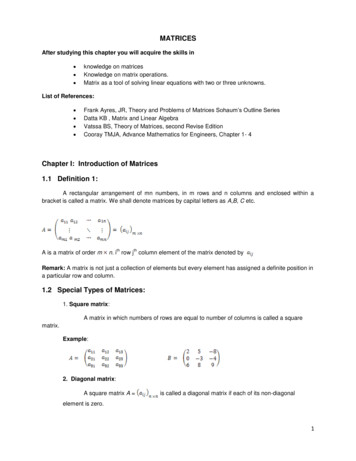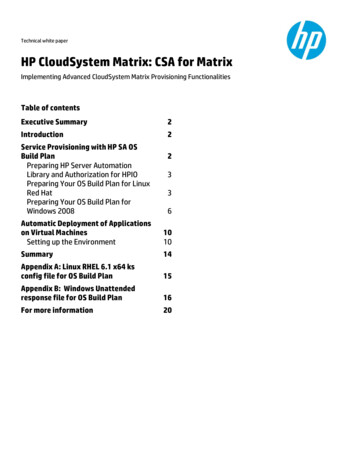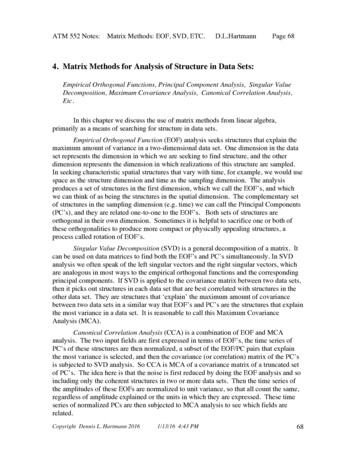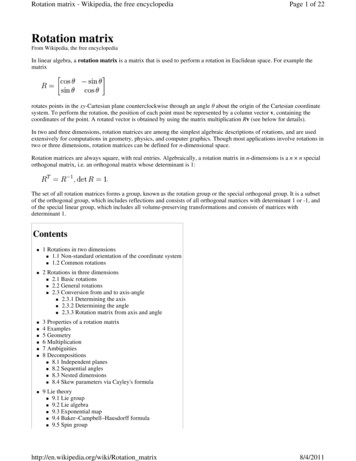
Transcription
Office of Juvenile Justice and Delinquency PreventionMatrix ofCommunity-Based InitiativesMAY 1995Program SummaryNT OFJUSSG OVCRAMSDEPANBJ A C EIOF FOffice of Justice ProgramsMERTCETIU.S. Department of JusticeIJBJ OO F OJJ D PRJ US T I C E P
Matrix of Community-Based InitiativesForewordOffice of Juvenile Justice and Delinquency PreventionOffice of Justice Programs, U.S. Department of JusticeIn order to assist States, local units of government, and nonprofit organizations in their efforts tostrengthen communities and reduce violence and delinquency, the Office of Juvenile Justice andDelinquency Prevention (OJJDP) has developed the Matrix of Community-Based Initiatives. Thematrix indicates in graph format the collocations of major public and private comprehensivecommunity-based violence prevention and economic development initiatives that could assist indelinquency prevention efforts. It identifies jurisdictions from across America that are FederalEmpowerment Zones, Enterprise Communities, PACT sites, Weed and Seed neighborhoods,participants in the Community Partnership Demonstration Program, or the site for other Federal orphilanthropic communitywide initiatives.The initiative included in the matrix are guided by varying goals, from violence and substance abuseprevention to economic development. They also differ according to the scope of the geographic areathey target, from countywide violence reduction to neighborhood-focused gang prevention. Whateach initiative has in common, however, is an interdisciplinary local planning board that has includedin its focus improving the lives of at-risk children and families.This report is divided in two parts. The first section provides a brief narrative description of eachmajor Federal or private initiative, including a contact person within the Federal department or thefoundation who can provide additional information about the initiative and a local contact person.It also furnishes similar information on major initiatives such as SafeFutures, Early Head Start, andFACES, for which sites have not yet been selected, to encourage currently operating initiatives toapply for these programs or to facilitate their strategic planning.Following the narrative descriptions is the matrix. Along the vertical axis of the chart, the States arelisted alphabetically, each followed by the cities, counties, or jurisdictions within that State where thecomprehensive initiatives are located. Along the horizontal axis, the initiatives are identified andorganized by Federal department and foundation.The matrix is not exhaustive, but rather features significant activities within the private sector andeach Federal agency. In the case of certain initiatives, which are operating in many jurisdictionsacross the country, the matrix indicates only those programs that are found in sites with othercommunitywide delinquency prevention programs included in this report. Community policing andthe Public Housing Drug Elimination program are examples of such initiatives with which everycommunity should be engaged due to their wide-ranging implementation.This intention of this matrix is to enhance collaboration, at both the national and local levels, among
programmatic activities that share the same philosophy. This coordination will aid in leveraging localsupport and funds to improve the quality and delivery of services and programs, and will ultimatelylead to improved outcomes for at-risk youth, families, and communitiesShay BilchikAdministrator
.Matrix Of Community-Based InitiativesProgram Descriptions.OJJDPOffice of Juvenile Justice and Delinquency Prevention
.Matrix Of Community-Based Initiatives.OJJDPOffice of Juvenile Justice and Delinquency Prevention
U.S. Department of Housing and Urban DevelopmentEmpowerment ZonesThe goal of the Empowerment Zones is to revitalize communities through economic and socialservices, using a community planning process that brings together public and private sectors. Theplanning process produces a coordinated strategy to use Federal tax initiatives, deregulation,Federal program waivers, and flexible Federal program funding to encourage economic selfsufficiency in the community. Empowerment Zones also offer a wide range of traditional socialservices, community development, and crime prevention programs.Empowerment Zones, nominated by both local and State governments, present a strategic planbased on input from the "affected community" and local organizations. The plan must includeperformance standards to measure the "extent to which poor persons and families will beempowered to become economically self-sufficient," must contain written assurances from localand State governments about implementation, and must include significant commitments from theprivate sector. The plan also must address economic, human, community, and physicaldevelopment of the zone; and current State, Federal, and local public and private resources.Contact:Howard GlaserDepartment of Housing and Urban Development451 Seventh Street SE.Washington, DC 20410202-708-2690Enterprise CommunitiesEnterprise Communities (similar to Empowerment Zones) are selected based on the communities'ability to satisfy four fundamental principles: economic opportunity, community development,community participation, and vision for change. Economic opportunity includes creating jobs,attracting private partnerships, and training residents for new job opportunities. EnterpriseCommunities strive for sustainable community development by promoting physical and humandevelopment—such as safe streets, clean air and water, commitment to personal and communityresponsibility—as part of their economic strategies. An essential ingredient of the strategic plan isthe inclusion of community-based partnerships. Finally, a strategic vision and plan for change thatcoordinates the response to the needs of the community by integrating economic, physical,human, and other strategies is the final program principle. Federal initiatives for EnterpriseCommunities include tax incentives, flexible block grants, waivers/flexibility with existing Federalresources, and priority consideration for discretionary Federal funds.1
Contact:Howard GlaserDepartment of Housing and Urban Development451 Seventh Street SE.Washington, DC 20410202-708-2690Family Investment CentersThrough the National Affordable Housing Act, the Department of Housing and UrbanDevelopment makes grants to public housing authorities to provide families and youth with betteraccess to education and employment opportunities so they can achieve economic self-sufficiency,improve their quality of life, and ultimately decrease drug and crime problems. The FamilyInvestment Center (FIC) grant program provides for the integrated delivery of a variety ofservices to enhance community development. This includes funds for supportive services inFamily Investment Centers such as child care, employment training and counseling, supportivehealth care, transportation, computer skills training, and literacy training. In 1994, a 5 millionset-aside from FIC supported five Youth Development Initiative sites, which are specificallygeared toward providing youth-related activities and services such as training and assistance inattaining certificates of high school graduate equivalency (GED), and entrepreneurship training.In 1995, 10 million will be made available for this initiative. In addition to the provision ofsupportive services, the youth FIC funds may be used to renovate, convert, acquire, or build newfacilities to house the provisions of supportive services provided to the youth.Contact:Bertha JonesOffice of Public and Indian HousingU.S. Department of Housing and Urban Development451 Seventh Street SW.Washington, DC 20410202-708-4214, Ext. 2822
National Youth Sports ProgramThe National Youth Sports Program (YSP) provides positive alternative activities for at-riskyouth. Grants are provided for youth sports, recreational, cultural, and educational programsinitiated in public housing communities. YSP acts as a vehicle for youth to develop leadershipskills, gain self-esteem, learn the value of teamwork, and exercise self-empowerment in a positiveand drug-free environment. The program complements HUD's Public and Indian Housing DrugElimination Program.Note: The Matrix of Community-Based Initiatives identifies only those YSP programs that arefound in sites with other delinquency prevention initiatives included in this report. For acomplete listing of YSP sites, contact the HUD representative listed below.Contact:Ed MosesCommunity Relations and InvolvementOffice of Public and Indian HousingU.S. Department of Housing and Urban Development451 Seventh Street SW., Room 4102Washington, DC 20410202-619-8201Public Housing Drug Elimination ProgramThe Public Housing Drug Elimination Program (PHDEP) was established in 1988 to help localagencies combat drug trafficking in public and Indian housing developments. PHDEP enablespublic housing authorities to address drug-related activities in ways such as reimbursing local lawenforcement agencies, providing physical improvements to enhance security in the housingdevelopment, and creating social service programs. Congress has appropriated funds for thisprogram since 1989. In 1994, HUD made 520 awards through this initiative.Note: The Matrix of Community-Based Initiatives identifies only those PHDEP programs thatare found in sites with other delinquency prevention initiatives included in this report. For acomplete listing of PHDEP sites, contact the HUD representative listed below.3
Contact:Ed MosesCommunity Relations and InvolvementOffice of Public and Indian HousingU.S. Department of Housing and Urban Development451 Seventh Street SW., Room 4102Washington, DC 20410202-619-8201Tenant Opportunities ProgramThe Public Housing Resident Management Program was created in 1988 to provide technicalassistance to elected resident management organizations. The Department of Housing and UrbanDevelopment recently issued a final ruling that expanded the resident management program byenabling residents to play a more active role in the daily governance of their communities. TheTenant Opportunities Program (TOP) expands existing training opportunities for public housingresidents, and supports resident initiatives such as tenant patrols, resident-owned businesses, andeconomic development projects.Note: The Matrix of Community-Based Initiatives identifies only those TOP programs that arefound in sites with other delinquency prevention initiatives included in this report. For acomplete listing of TOP sites, contact the HUD representative listed below.Contact:Ed MosesCommunity Relations and InvolvementOffice of Public and Indian HousingU.S. Department of Housing and Urban Development451 Seventh Street SW., Room 4102Washington, DC 20410202-619-8201YouthBuildThe YouthBuild Program is designed to help disadvantaged young adults who have dropped outof high school obtain employment and education skills that will help them achieve economic selfsufficiency. The program also helps these young adults develop leadership skills and acommitment to community development in low-income communities.4
Note: The Matrix of Community-Based Initiatives identifies only those YouthBuild programs thatare found in sites with other delinquency prevention initiatives included in this report. For acomplete listing of YouthBuild sites, contact the HUD representative listed below.Contact:Ron HerbertOffice of Economic DevelopmentU.S. Department of Housing and Urban Development451 Seventh Street SW., Room 7136Washington, DC 20410202-708-34845
U.S. Department of JusticeCommunity PolicingCommunity policing is an organizationwide philosophy and management approach that promotescommunity, government, and police partnerships; proactive problem solving; and communityengagement to address the causes of crime, fear of crime, and other community issues.Community policing consists of two core components--community partnership and problemsolving--and brings together the community, police, and government to address crime. Throughcommunity policing problems are identified and strategies are developed to address a multitude ofissues associated with crime and quality of life at a neighborhood level. Problems such as gangs,drugs, and youth violence are among the many problems that have been identified in variouscommunities. The Bureau of Justice Assistance (BJA) has funded community policingdemonstration projects since 1986. Most recently, BJA established a demonstration programwhich focuses on the design, development, and implementation of community policing on adepartmentwide basis. The community policing demonstration program is currently beingimplemented in 14 cities around the country. Additionally, BJA is funding three rural jurisdictionsto develop and implement community policing. These sites are Phoenix, Arizona; Hayward,California; San Diego, California; Denver, Colorado; Ft. Pierce, Florida; Hillsborough County,Florida; St. Petersburg, Florida; Caldwell, Idaho; Chicago, Illinois; Richmond, Maine; Ann Arbor,Michigan; St. Paul, Minnesota; Rochester, New York; Eugene, Oregon; Memphis, Tennessee;Austin, Texas; and Spokane, Washington.In addition to these demonstration programs, the Office for Community Oriented of PolicingServices has awarded grants to local communities through the Violent Crime Control and LawEnforcement Act of 1994. These grants speed the deployment of new offices devoted tocommunity policing on the streets and rural routes of the Nation. COPS AHEAD benefitsjurisdictions with populations of 50,000 or more, and COPS FAST is aimed at jurisdictions withpopulations under 50,000. Future funds for community policing will continue to be availablethrough the Office for Community Oriented Policing Services.Note: Community policing grants have been awarded to thousands of communities across thecountry. The matrix identifies only those community policing grantees and demonstrationprograms that are found in sites with other delinquency prevention initiatives included in thisreport. For a listing of grantees in your area, contact the Community Oriented Policing Servicesagency representative listed below.6
Contact:Maggie HeislerBureau of Justice Assistance633 Indiana Avenue NW.Washington, DC 20531202-616-3452Pam CammarataCommunity Oriented Policing Services1100 Vermont Avenue NW.Washington, DC 20530202-514-4101Comprehensive Communities ProgramThe Comprehensive Communities Program provides grants to cities with high rates of drugrelated crime and violence to develop a comprehensive strategy for crime and drug control. Theprogram requires that law enforcement agencies, other government agencies, and the communitywork together to address these problems. These strategies must demonstrate jurisdictionwidecommitment to community policing; coordination of public and private agency efforts (includingsocial services and public health); and efforts to encourage citizen participation in problemsolving. Strategies also must include:An analysis of jurisdictionwide crime problems, with special attention to drugs, gangs, andviolence.An analysis of the economic and social problems.A description of the current police and community efforts and relationships.An inventory of all community resources which are and could be directed towardaddressing these problems.A description of coordination and cooperation efforts within the criminal justice system.A description of specific strategies and innovations that will be employed to respond to theidentified problems.An implementation plan.A plan for addressing how well the strategy was implemented and its impact on the citedproblems.Funding also is available to support a number of program components within thecomprehensive strategy. They include jurisdictionwide community policing; community7
mobilization/prevention initiatives; youth and gangs; community prosecution and diversion; drugcourts with diversion to treatment; community-based alternatives to incarceration; training andtechnical assistance; and program evaluation.Contact:Jay MarshallBureau of Justice AssistanceU.S. Department of Justice633 Indiana Avenue NW.Washington, DC 20531202-514-5943Interagency Gun Demonstration ProgramThe National Institute of Justice (NIJ), the Office of Juvenile Justice and Delinquency Prevention(OJJDP), and the Centers for Disease Control (CDC) are funding studies relating to theprevention and control of juvenile firearms violence. Several studies will producerecommendations for intervention and prevention programs. Some will be collecting data aboutthe use of firearms by juveniles. Other studies will evaluate programs that use techniques forproblem identification and solving to design, implement, and evaluate prevention and interventionstrategies for reducing juvenile access to guns and reducing youth gun violence. Several projectsare multidisciplinary; they involve the criminal and juvenile justice system, as well as public health,social service, and other local agencies, researchers, and evaluators. One of these studies (inAtlanta, Georgia) is cofunded by NIJ, OJJDP, and CDC.Contact:Lois MockNational Institute of Justice633 Indiana Avenue NW.Washington, DC 20531202-307-0693Native American Alternative Community-Based ProgramThe Native American Alternative Community-Based Program is a collaborative effort between theOffice of Juvenile Justice and Delinquency Prevention and the Department of Health and HumanServices' Indian Health Service. Through this effort, grantees develop community-basedalternative programs for Native American youth who have been adjudicated delinquents or whoare returning from institutional placement. A multicomponent design is being8
developed to integrate the critical elements of intensive supervision and community-basedaftercare with cultural elements that have been traditionally used by Native Americans tocontrol and rehabilitate offending youth. The Indian Health Service is providing treatment,technical assistance, and training for the programs. The training focuses on mental health,adolescent development, behavior management, substance abuse, and other related subjects.Contact:Eugene RhodenOffice of Juvenile Justice and Delinquency Prevention633 Indiana Avenue NW.Washington, DC 20531202-616-3662Operation Weed and SeedOperation Weed and Seed is a multiagency strategy that "weeds out" violent crime, gang activity,drug use, and drug trafficking in targeted high-crime neighborhoods and then "seeds" and restoresthese neighborhoods through social and economic revitalization. The Weed and Seed strategyrecognizes the importance of linking and integrating Federal, State, and local law enforcement andcriminal justice efforts with social services, the private sector, and the community to maximize theimpact of existing programs and resources. It also recognizes the importance of community andprivate sector involvement.The four basic elements of Weed and Seed are suppression (coordinating law enforcement effortsto "weed out" violent offenders); community-oriented policing (implementing community-orientedpolicing and working with residents of the community to develop solutions to the problems ofviolent and drug-related crime); prevention, intervention, and treatment (joining law enforcement,social services, and the private sector as partners in preventing crime and violence by focusinghuman services in the area); and neighborhood restoration (revitalizing distressed areas witheconomic development and economic opportunities made available through Federal, State, andlocal agencies and the private sector).Contact:Terry DonahueBureau of Justice AssistanceU.S. Department of Justice633 Indiana Avenue NW.Washington, DC 20531202-307-59669
Pulling America's Communities TogetherPulling America's Communities Together (PACT) is an initiative that links the FederalGovernment and State and local agencies to empower communities to reduce crime and violence.The Departments of Education, Health and Human Services, Housing and Urban Development,Justice, and Labor, as well as the Office of National Drug Control Policy, launched this effort as acomponent of the Interdepartmental Task Force on Violence.Through PACT the Federal Government vigorously fosters and supports the development ofbroad-based, fully coordinated local and Statewide initiatives to secure community safety.Communities play the lead role in crafting solutions to address local problems. The FederalGovernment supports and assists communities as they build coalitions and provides informationabout programs that have antiviolence strategies. This project served as the impetus for thedevelopment of Partnerships Against Violence Network (PAVNET). PAVNET is acomputerized, interdepartmental system on the Internet that provides information on technicalassistance and model programs relating to violence reduction.Contact:Reginald L. RobinsonOffice of Justice Programs633 Indiana Avenue NW.Washington, DC 20531202-307-5933**********************Individual programs for the following Department of Justice initiatives were not funded at thetime this information was published. For information about these initiatives, contact the agencyrepresentative listed below.Drug CourtsThe Drug Court Program was authorized by Title V of the Violent Crime Control and LawEnforcement Act of 1994. Through this program grants are being made to units of localgovernment, Indian tribal governments, and State and local courts for assistance with drug courtprograms that involve continuing judicial supervision over nonviolent offenders with substanceabuse problems. These drug court programs also involve the coordination of administration ofother sanctions and services, including mandatory periodic drug testing; substance abusetreatment; diversion, probation, and other supervised release programs and activities; and offendermanagement and aftercare services.10
Contact:Tim MurrayOffice of Justice Programs633 Indiana Avenue NW.Washington, DC 20531202-616-5001SafeFutures: Partnerships to Reduce Youth Violence and DelinquencyThe SafeFutures Program calls on the community to enhance existing partnerships to address theneeds of at-risk and delinquency youth. These partnerships must include public and privateagencies; community-based organizations, such as religious, civic and business groups;community residents; and youth. The major goal of this program is to prevent and controljuvenile delinquency through implementation of a strategy that is comprehensive, customerfocused, community-based, and draws on the resources of services agencies at all levels ofgovernment and the private sector. The strategy includes the development of a continuum of carefor all youth, with a particular focus on delinquent youth. Prevention and intervention, including arange of graduated sanctions and treatment services, comprise this continuum. Partnerships,availability of services, and community responsiveness lie at the heart of SafeFutures.This initiative places a strong premium on linkages to other ongoing Federal, State, local, andtribal initiatives concerned with youth development, economic development, and public safety.Five sites (three urban, one rural, and one tribal government) will be funded. Two of the foururban/rural sites will be designated Empowerment Zones/Enterprise Communities. Funds will beused to support nine different programs ranging from prevention through aftercare but linkedtogether as part of a broader comprehensive program. A total of 7,200,000 is available for FY95. Total length of the program is 5 years, conditioned on grantee performance and availability offuture funds.Contact:Betty ChemersSpecial Emphasis DivisionOffice of Juvenile Justice and Delinquency Prevention633 Indiana Avenue NW.Washington, DC 20531202-307-591411
Tribal Strategies Against Violence—Project (TSAV)Tribal Strategies Against Violence (TSAV) is a Federal/tribal partnership initiative designed toempower American Indian communities to confront violence and violent crime. The purpose ofthis project is to stimulate and encourage communities to develop strategies to reduce theincidence of family violence, child abuse, and juvenile delinquency, as well as to foster communityparticipation and support in implementing these strategies. Project TSAV will help to createeffective mechanisms to strengthen the ability of tribal communities to address problems related toviolent crime in a culturally appropriate and meaningful context. This program is modeled afterProject PACT, an interdepartmental initiative aimed at organizing America's cities againstviolence.Contact:Byron F. WongOffice of Justice ProgramsBureau of Justice Assistance633 Indiana Avenue NW.Washington, DC 20531202-514-627812
U.S. Department of Health and Human ServicesCommunity Demonstration GrantsThe aim of the Community Demonstration Grants program is to identify successful methods fordelivering youth violence interventions at the community level and to determine if multifacetedcommunity programs can reduce rates of violent behavior, injury, and death associated with youthviolence. The Centers for Disease Control (CDC) helps communities to design and implementmultifaceted community youth violence prevention programs. CDC funds three demonstrationgrant projects that provide information about the effectiveness of community agencies and groupsworking in coordinated efforts with multiple, complementary interventions. These projects arelocated in Brooklyn, New York; Houston, Texas; and Durham, North Carolina. In addition, CDCfunds 11 singled-focused intervention sites across the country.Contact:Timothy Thornton4770 Buford Highway, Mail Stop K60Atlanta, GA 30341404-488-4389Community Partnership Demonstration ProgramThe goal of the Community Partnership Demonstration Program (CPDP) is to promote thedevelopment of long-range, comprehensive, multidisciplinary communitywide programsconcerning drug use and alcohol abuse prevention. Programs are aimed at reducing theincidence and prevalence of alcohol, tobacco, and other drug use, as well as the problemsaccompanying such behavior. This is accomplished through the formation and support ofcoalitions or partnerships comprised of public and private organizations, agencies, andinstitutions, consortiums, and local communities.The Center for Substance Abuse Prevention (CSAP), within the Substance Abuse and MentalHealth Services Administration (SAMHSA), provides Federal leadership for this effort. Funds areused to identify the needs and service gaps in each community, to establish priorities, tocoordinate new and established prevention programs in the community, and to help public andprivate organizations promote and support drug abuse prevention programs.13
Note: The Matrix of Community-Based Initiatives identifies only those CPDP programs that arefound in sites with other delinquency prevention initiatives included in this report. For acomplete listing of CPDP sites, contact the HHS representative listed below.Contact:David RobbinsCommunity Prevention and Demonstration BranchCenter for Substance Abuse PreventionRockwall II Building, Room 9D-185600 Fishers LaneRockville, MD 20857301-443-2068Family Preservation and SupportThe Family Preservation and Support Program provides Federal resources for family preservationand support services. The program supports ongoing State efforts and helps States create newways to promote family strength and stability, enhance parental functioning, and protect children.Nearly 1 billion is being made available over 5 years to States and a limited number of tribes forprevention services (family support services) and services to families at risk or in crisis (familypreservation services).The program offers States an extraordinary opportunity to make sweeping changes in the childwelfare system. These changes are aimed at helping vulnerable children and their families,particularly those who are at risk for abuse and neglect. The program emphasizes a coordinated,integrated, culturally relevant, family-focused approach. It also encourages active participation ofparents, consumers, advocates, Indian tribes, courts, community representatives, and State, local,and nonprofit agencies and community-based organizations.Contact:Daniel H. LewisChildren's BureauAdministration on Children, Youth, and FamiliesP.O. Box 1182Washington, DC 20013202-205-861814
Healthy Start SitesA total of 22 communities with high infant mortality rates have received Federal grants to developinnovative approaches to cut their rates in half by 1996. The goals of Healthy Start are toincrease awareness of infant mortality and overcome barriers to receiving child and maternalhealth; to streamline and coordinate services between public and private agencies; and to buildpartnerships among families, volunteers, companies, and health care and social service providers.Healthy Start integrates health care and facilitating social services, and offers social and healthservices in one location. It uses a case management approach to reduce barriers to participationin Medicaid; the Women, Infants, and Children (WIC) programs; food stamps; public housing;and health care services. Healthy Start tr
Community policing consists of two core components--community partnership and problem solving--and brings together the community, police, and government to address crime. Through community policing problems are identified and strategies are developed to address a multitude of issues associated with crime and quality of life at a neighborhood level.











